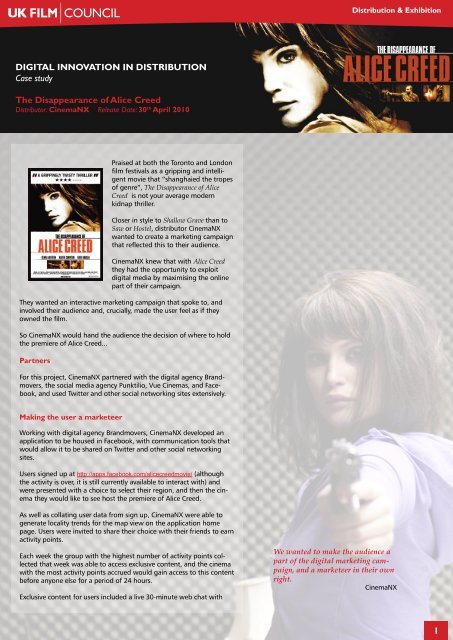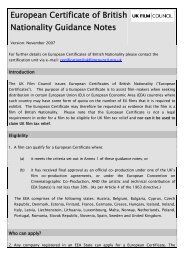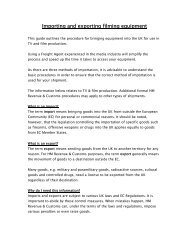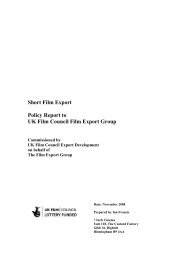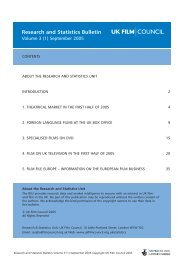DIGITAL INNOVATION IN DISTRIBUTION Case study The ... - BFI
DIGITAL INNOVATION IN DISTRIBUTION Case study The ... - BFI
DIGITAL INNOVATION IN DISTRIBUTION Case study The ... - BFI
You also want an ePaper? Increase the reach of your titles
YUMPU automatically turns print PDFs into web optimized ePapers that Google loves.
<strong>DIGITAL</strong> <strong><strong>IN</strong>NOVATION</strong> <strong>IN</strong> <strong>DISTRIBUTION</strong><br />
<strong>Case</strong> <strong>study</strong><br />
<strong>The</strong> Disappearance of Alice Creed<br />
Distributor: CinemaNX Release Date: 30 th April 2010<br />
Praised at both the Toronto and London<br />
film festivals as a gripping and intelligent<br />
movie that “shanghaied the tropes<br />
of genre”, <strong>The</strong> Disappearance of Alice<br />
Creed is not your average modern<br />
kidnap thriller.<br />
Closer in style to Shallow Grave than to<br />
Saw or Hostel, distributor CinemaNX<br />
wanted to create a marketing campaign<br />
that reflected this to their audience.<br />
CinemaNX knew that with Alice Creed<br />
they had the opportunity to exploit<br />
digital media by maximising the online<br />
part of their campaign.<br />
<strong>The</strong>y wanted an interactive marketing campaign that spoke to, and<br />
involved their audience and, crucially, made the user feel as if they<br />
owned the film.<br />
So CinemaNX would hand the audience the decision of where to hold<br />
the premiere of Alice Creed...<br />
Partners<br />
For this project, CinemaNX partnered with the digital agency Brandmovers,<br />
the social media agency Punktilio, Vue Cinemas, and Facebook,<br />
and used Twitter and other social networking sites extensively.<br />
Making the user a marketeer<br />
Working with digital agency Brandmovers, CinemaNX developed an<br />
application to be housed in Facebook, with communication tools that<br />
would allow it to be shared on Twitter and other social networking<br />
sites.<br />
Users signed up at http://apps.facebook.com/alicecreedmovie/ (although<br />
the activity is over, it is still currently available to interact with) and<br />
were presented with a choice to select their region, and then the cinema<br />
they would like to see host the premiere of Alice Creed.<br />
As well as collating user data from sign up, CinemaNX were able to<br />
generate locality trends for the map view on the application home<br />
page. Users were invited to share their choice with their friends to earn<br />
activity points.<br />
Each week the group with the highest number of activity points collected<br />
that week was able to access exclusive content, and the cinema<br />
with the most activity points accrued would gain access to this content<br />
before anyone else for a period of 24 hours.<br />
Exclusive content for users included a live 30-minute web chat with<br />
Distribution & Exhibition<br />
We wanted to make the audience a<br />
part of the digital marketing campaign,<br />
and a marketeer in their own<br />
right.<br />
CinemaNX<br />
1
the film’s director, J Blakeson (recorded and edited for other users to<br />
view after the winning cinema’s exclusive period had elapsed), along<br />
with original storyboards and exclusive stills. CinemaNX also created<br />
two unique pieces of film content featuring the film’s star, Gemma<br />
Arterton, which were only available for viewing by application users.<br />
All marketing activity by the user increased the activity points for the<br />
cinema group, encouraging users to remain engaged with the digital<br />
marketing campaign.<br />
Planning the campaign<br />
<strong>The</strong> ultimate aim of involvement with the application was to win their<br />
chosen cinema the right to host the premiere of the film, and all users<br />
in the cinema’s group would be offered cinema tickets to allow them<br />
the kind of red carpet access usually restricted to the film industry and<br />
guests of West End premieres.<br />
CinemaNX created a dynamic incentive for user activity through a suite<br />
of tools, which participants could use to generate support for their<br />
cinema, and earn themselves activity points. <strong>The</strong>se tools, intended to<br />
facilitate a viral effect, were a combination of Facebook standard communicators,<br />
and on-brand messages relating<br />
to movie items or activities.<br />
<strong>The</strong> toolkit included:<br />
Invite Share<br />
Users selected Facebook friends and sent invitations to install the application.<br />
<strong>The</strong>se were represented as calls to action to support the user’s selected<br />
local cinema, but also allowed an option for recipients to select or<br />
nominate their own cinema.<br />
Each invited friend that installed the application and supported the<br />
original user’s cinema earned the user 100 activity points. Each referred<br />
installation which supported another cinema earned 20 activity<br />
points, and each invitation sent but not completed earned 2 activity<br />
points.<br />
Publish to newsfeed Find Item<br />
Individual components or activities were automatically published to a<br />
user’s newsfeed and were visible to all of their friends.<br />
<strong>The</strong>se included their cinema’s current position in the rankings, their<br />
own position within the local activity chart or certain milestones being<br />
reached (cinema has 100, 1000, 10000 supporters etc).<br />
One successful model, inspired by both Facebook phenomenon Farmville<br />
and the social media tool Foursquare, was to provide badges to<br />
users on once they hit pre-defined numbers of activity points.<br />
<strong>The</strong> user was made aware of these from the outset with a grid, which<br />
highlighted what still needed to be achieved, thus providing a direct<br />
incentive to complete the tasks.<br />
Map view Leaderboard<br />
An interactive map was displayed on the application home page,<br />
showing the whole of the UK and overlaid with colour tones to show<br />
hotspots of activity.<br />
Users could then click to zoom into areas and eventually to a level<br />
where individual cinemas were shown. This could be used to find local<br />
cinemas and then vote, and utilised Google Maps via an API.<br />
<strong>DIGITAL</strong> PROPOSAL BREAKDOWN Cost<br />
Front-end template creation £1600<br />
Facebook application build and integration £6000<br />
Map module & integration £2700<br />
Unveil functionality £2000<br />
Discount codes integration £800<br />
Vote feature £1600<br />
Survey feature £800<br />
Design and Asset build £3500<br />
Content Production £100<br />
Seeding costs £5885<br />
Facebook ad drivers £2000<br />
Premiere Costs £3015<br />
TOTAL £30000<br />
Users used the Facebook ‘share’ function to publish a call to action to<br />
their newsfeed, which would proclaim their support and encourage<br />
their friends to join the campaign.<br />
Each time this was performed, up to a maximum of three per day per<br />
person, users earned 10 activity points. Each time their share was clicked<br />
upon by another Facebook user, 2 points were earned.<br />
<strong>The</strong> system randomly generated instances where items or non-exclusive<br />
content were made available to a user within the application, which<br />
could then be accessed at any time or shared using the tools described<br />
above.<br />
<strong>The</strong>se were brand items from the film such as Alice’s mobile telephone.<br />
Clicking to store the item earned activity points, as did sharing and<br />
friend’s viewing.<br />
A leaderboard ran along the right hand side of the application homepage<br />
detailing the top ten cinemas in competition for the premiere and<br />
a percentage of the votes earned.<br />
Ultimately, all of the above were vehicles for spreading awareness of the<br />
application via social networking tools, providing a personal incentive<br />
to ensure repeat activity and so that the primary message would be<br />
regularly transmitted.<br />
2
Preparing the campaign<br />
CinemaNX chose to work with social networking agency Punktilio after<br />
being very satisfied after working with them on the first CinemaNX<br />
distribution title, Richard Linklater’s Me and Orson Welles.<br />
Punktilio created early pre-awareness buzz, using overt and guerrilla<br />
promotional tactics to promote the application including searching for<br />
and messaging any groups and pages connected to all UK cinemas,<br />
and discreetly promoting the feature in comments left on online coverage,<br />
promoting the feature in forums and posting messages on any<br />
cinema-centric pages or groups throughout Facebook.<br />
Punktilio started “Let’s Win <strong>The</strong> Premiere In [an area]” groups on Facebook,<br />
and promoted these on relevant pages, gathering support on<br />
local forums and websites as well as posting in over twenty regional<br />
forums on online classified and communities website Gumtree.<br />
CinemaNX also bought 3 million targeted ASUs (an ASU is Facebook’s<br />
proprietary advertising unit), inviting users to ‘Win the Premiere’ of<br />
Alice Creed. <strong>The</strong>se adverts ran two weeks prior to release.<br />
Timings<br />
<strong>The</strong> initial plan had allowed for the campaign to run for three months<br />
but due to contractual issues, the launch was delayed and subsequently<br />
all timings were pushed back.<br />
<strong>The</strong> closing date of the application was also extended and the date for<br />
the premiere was set as 20th April 2010. <strong>The</strong> campaign would end up<br />
running for six weeks.<br />
Running the campaign<br />
<strong>The</strong> application was soft-launched to allow any issues to be ironed<br />
out. During this period, CinemaNX discovered that some of the mechanics<br />
involved were overly complicated or insufficiently explained to<br />
users. Reacting to this, they reduced the amount of detail for the user<br />
on how activity points were accumulated.<br />
Also during this period CinemaNX amended the leaderboard, from<br />
displaying the number of votes each cinema had received to each<br />
cinema’s percentage of the votes. This was due to the distribution of<br />
votes being such that early in the campaign, for example, a cinema in<br />
tenth position had only a handful of votes whereas the cinema in second<br />
place had several hundred. <strong>The</strong>y also changed the colour scheme<br />
of the map to make it easier to read.<br />
CinemaNX had hoped, in association with their partner cinema chain,<br />
to offer unique codes for all users of the application which could then<br />
be used to buy discounted tickets via the chain website. By ensuring<br />
these codes were unique and generated using a random string, they<br />
had hoped to reduce the risk of fraud and ensure that each code could<br />
be used only once to purchase.<br />
<strong>The</strong> idea was to drive sales and also provide a key identifier of campaign<br />
success which could have then been compiled with collated<br />
data to create a true breakdown of performance, follow-through and<br />
revenue generated.<br />
Ultimately there were too many technical issues involved in co-ordinating<br />
this plan with the box office system in place at the chain to allow<br />
this to happen. This unfortunately means that the ability to track the<br />
success of the campaign reliably was affected.<br />
If CinemaNX were to run the application again, they would begin<br />
everything earlier to allow for the three months as originally planned:<br />
3
the advertising campaign, the social networking work by Punktilio and<br />
the application itself, allowing for eWOM (electronic word-of-mouth)<br />
to spread, and the number of installs to increase.<br />
In terms of the advertising campaign itself, they would use interactive<br />
ads such as poll adverts rather than straightforward ASU, which have<br />
limited interactivity. CinemaNX feels the advertising campaign behind<br />
a highly interactive app should be reflective of the app itself. However,<br />
the allocation in the budget for these ads did not allow them to do<br />
this.<br />
CinemaNX would also seek to work with other brand partners to<br />
widen their communications on the application.<br />
How the campaign played out<br />
After initial competition between several cinema groups, a university<br />
film society in Southampton – Union Films – fully embraced the prospect<br />
of hosting the premiere, advertising to all their members, asking<br />
them to vote for their cinema on their university campus via posters,<br />
home page exposure on their website and through a newsletter.<br />
It was this interest in the increasing regional presence for the film that<br />
gained the film further coverage in regional and Scottish/Irish publications<br />
such as Venue, Leeds Guide, <strong>The</strong> List, Irish Times, Evening Herald<br />
– many of which detailed the underground approach of taking the<br />
premiere out of London.<br />
CinemaNX worked with Findanyfilm.com to create an MPU (a standard<br />
form of mid-page advertising unit measuring 300 × 250 pixels),<br />
shown on the right, to feature next to every cinema listing on their<br />
site (regardless of the film selected) encouraging users to click through<br />
and vote for their local cinema.<br />
Vue Cinemas were highly supportive of the ‘Win <strong>The</strong> Premiere’ competition<br />
and partnered with CinemaNX to target their extensive user<br />
database to vote for their local Vue cinema, by email newsletters with<br />
hyperlinks to the application.<br />
As momentum behind the application grew, a fierce but good-natured<br />
fight broke out between Vue Bury and the University of Southampton’s<br />
Union Films. Both of them harnessed word-of-mouth, Facebook,<br />
email and posters to encourage more users to vote for their cinema.<br />
At the end of a hard-fought battles, there could only be one eventual<br />
winner, which was Union Films.<br />
CinemaNX had built press coverage from a press release detailing the<br />
application. This included good coverage in <strong>The</strong> Observer and several<br />
trade publications. As the campaign drew to a close, the on- and offline<br />
teams managed to secure further exposure through great coverage<br />
of the event itself; with the paparazzi travelling from London to<br />
photograph Gemma Arterton’s appearance on the red carpet.<br />
Local and national coverage included ITN, <strong>The</strong> Observer, <strong>The</strong> Sun, Daily<br />
Mail, Metro, Life, Cineuropa, Female First, This Is Hampshire, Daily<br />
Echo. <strong>The</strong> application itself had extensive trade and consumer press in<br />
regional areas where cinemas were competing (e.g. Islington Gazette,<br />
Gravesend Reporter).<br />
Alice Creed was one of the most covered premieres that week due to<br />
the uniqueness of the location and the approach.<br />
Union Films fully embraced the prospect of hosting the event: organising<br />
all ticket redemption and, with CinemaNX, coordinating all marketing<br />
materials including the creation of banners, hiring of a red carpet<br />
and associated security staff, laying on a champagne reception and<br />
hiring a photographer.<br />
<strong>The</strong> members of the University’s film society dressed up for the occasion<br />
and the result was a massive success.<br />
F<strong>IN</strong>AL RESULTS<br />
1st Union Films (Southampton)<br />
2nd Vue (Bury)<br />
3rd Vue (Bolton)<br />
4th Screen On <strong>The</strong> Green (London)<br />
5th Vue Atrium (Camberley)<br />
We were all blown away by how incredible<br />
the premiere was. Particularly<br />
in comparison to the usual type hosted<br />
in the West End.<br />
CinemaNX<br />
4
<strong>The</strong> aim of the campaign had been fully achieved: allowing the<br />
cinemagoer to assist in moulding the shape of the campaign, allowing<br />
them to engage and be creative with the marketing assets whilst<br />
spreading traditional awareness (via PR and advertising) of the film<br />
into the regions.<br />
<strong>The</strong> film’s performance<br />
<strong>The</strong> Disappearance of Alice Creed was the key indie contender against<br />
blockbuster Iron Man 2 and Miley Cyrus vehicle <strong>The</strong> Last Song, beating<br />
<strong>The</strong> Last Song on their opening weekend by £64 a screen. CinemaNX<br />
view this as quite an achievement considering the huge spend afforded<br />
to a studio film compared to a small British indie.<br />
<strong>The</strong> film also beat other titles Revanche, Milk of Sorrow and Sura, and<br />
gained a higher screen average than similar-sized releases around the<br />
same time, such as Greenberg and <strong>The</strong> Killer Inside Me.<br />
With a current total gross of over £400,000 following its initial 67<br />
print release, and with a 4 day weekend screen average of nearly<br />
£3000, the film punched well above its weight.<br />
Owing to the film’s opening weekend success, CinemaNX were able to<br />
add Vue Eastleigh (five miles outside Southampton) to their bookings -<br />
due to the regional popularity of the film after the premiere.<br />
Proof of the film’s success is that, close to three months after its April<br />
30 release, the film was still playing off-dates across the country,<br />
including Stamford Arts Centre, Odeon Southend, Riverside Hammersmith,<br />
Eden Court <strong>The</strong>atre and Odeon Belfast.<br />
<strong>The</strong> campaign has also had industry acclaim with its nomination for<br />
Premiere of the Year in Screen International’s Screen Awards 2010,<br />
up against Avatar and Twilight: suggesting an innovative marketing<br />
campaign for a lower budget indie film could succeed in a competitive<br />
marketplace.<br />
5
Conclusion<br />
Working closely with Brandmovers and Punktilio, CinemaNX expanded<br />
the regional awareness of the film and were able to profile the audience<br />
and interact directly with fans of the film. It is CinemaNX’s belief<br />
that the film’s box office performance owed much to their targeting<br />
their key audience.<br />
But it was perhaps the spill-over effects of the campaign – the PR<br />
gained and eWOM – which really assisted in a successful opening<br />
weekend.<br />
This campaign combined viral tools within social media, and an offline<br />
hook that the mainstream media could pick up. This meant that<br />
awareness grew from a small group of app users into a wider network<br />
online, and ultimately to a far larger audience, many of whom may<br />
never have been exposed to the online activity.<br />
App<br />
Users<br />
Viral tools<br />
(share/<br />
invite/<br />
publish etc)<br />
Aware of<br />
the app /<br />
competition<br />
Media<br />
interest<br />
Aware of<br />
the premiere<br />
(so aware of the<br />
film release)<br />
CinemaNX now has a database of Facebook users along with each<br />
user’s email address, their region and favourite cinema, all of which<br />
can be used for future marketing, future theatricals and of course,<br />
DVD sales. This, together with the profile achieved in the theatrical release,<br />
mean they can expect good awareness of the DVD release, and<br />
they look forward to strong sales on October 4.<br />
Learning from this experience, future applications would employ a very<br />
simple interface with one simple hook – CinemaNX felt, in conclusion,<br />
that simply competing to win the premiere may have proved sufficient<br />
without the object collection element.<br />
<strong>The</strong>y would also begin everything earlier, to allow for the three months<br />
as originally planned: the advertising campaign, the social networking<br />
work and the application itself, allowing for eWOM to spread, and<br />
the number of installs to increase. <strong>The</strong>y would also seek to work with<br />
other brand partners to widen their communications on the application.<br />
Budgetary constraints aside, in terms of the advertising campaign, in<br />
future CinemaNX would use interactive ads such as poll adverts rather<br />
than straightforward ASU, which have limited interactivity. <strong>The</strong>y feel a<br />
campaign behind a highly interactive app should be reflective of the<br />
app itself. <strong>The</strong>y also also feel that having an iPhone and iPad application<br />
might have increased participation and awareness of the application.<br />
CinemaNX believe the knowledge and methodology gained with<br />
regards harnessing social media has thoroughly prepared them for<br />
future digital campaigns.<br />
VITAL STATISTICS<br />
Application installs 2088<br />
Total invites sent 6693<br />
Total share actions 991<br />
Application views (canvas views) 19400<br />
Active users at time of poll closing 6557<br />
Facebook ‘fans’ 6000<br />
6


